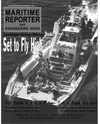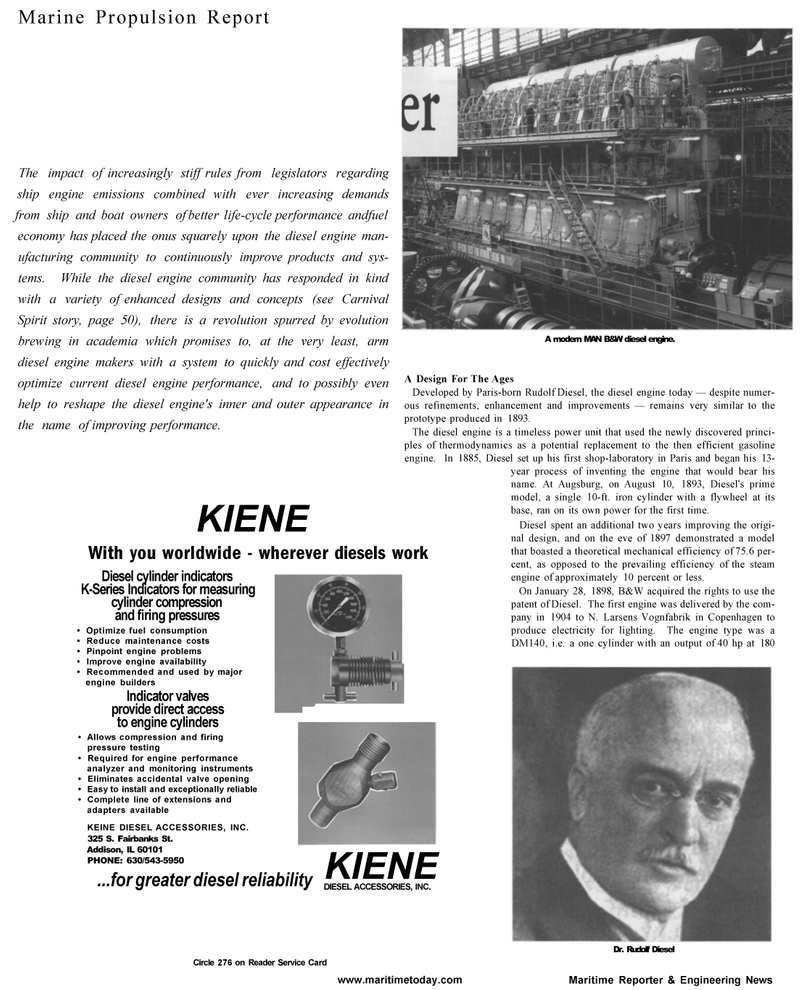
Page 44: of Maritime Reporter Magazine (January 2001)
Read this page in Pdf, Flash or Html5 edition of January 2001 Maritime Reporter Magazine
The impact of increasingly stiff rules from legislators regarding ship engine emissions combined with ever increasing demands from ship and boat owners of better life-cycle performance andfuel economy has placed the onus squarely upon the diesel engine man- ufacturing community to continuously improve products and sys- tems. While the diesel engine community has responded in kind with a variety of enhanced designs and concepts (see Carnival
Spirit story, page 50), there is a revolution spurred by evolution brewing in academia which promises to, at the very least, arm diesel engine makers with a system to quickly and cost effectively optimize current diesel engine performance, and to possibly even help to reshape the diesel engine's inner and outer appearance in the name of improving performance.
A modern MAN B&W diesel engine.
A Design For The Ages
Developed by Paris-born Rudolf Diesel, the diesel engine today — despite numer- ous refinements, enhancement and improvements — remains very similar to the prototype produced in 1893.
The diesel engine is a timeless power unit that used the newly discovered princi- ples of thermodynamics as a potential replacement to the then efficient gasoline engine. In 1885, Diesel set up his first shop-laboratory in Paris and began his 13- year process of inventing the engine that would bear his name. At Augsburg, on August 10, 1893, Diesel's prime model, a single 10-ft. iron cylinder with a flywheel at its base, ran on its own power for the first time.
Diesel spent an additional two years improving the origi- nal design, and on the eve of 1897 demonstrated a model that boasted a theoretical mechanical efficiency of 75.6 per- cent, as opposed to the prevailing efficiency of the steam engine of approximately 10 percent or less.
On January 28, 1898, B&W acquired the rights to use the patent of Diesel. The first engine was delivered by the com- pany in 1904 to N. Larsens Vognfabrik in Copenhagen to produce electricity for lighting. The engine type was a
DM140, i.e. a one cylinder with an output of 40 hp at 180
KIENE
With you worldwide - wherever diesels work
Diesel cylinder indicators K-Series Indicators for measuring cylinder compression and firing pressures • Optimize fuel consumption • Reduce maintenance costs • Pinpoint engine problems • Improve engine availability • Recommended and used by major engine builders
Indicator valves provide direct access to engine cylinders • Allows compression and firing pressure testing • Required for engine performance analyzer and monitoring instruments • Eliminates accidental valve opening • Easy to install and exceptionally reliable • Complete line of extensions and adapters available
Marine Propulsion Report
KIENE
DIESEL ACCESSORIES, INC.
KEINE DIESEL ACCESSORIES, INC. 325 S. Fairbanks St.
Addison, IL 60101
PHONE: 630/543-5950 ...for greater diesel reliability
Circle 276 on Reader Service Card www.maritimetoday.com
Dr. Rudolf Diesel
Maritime Reporter & Engineering News

 43
43

 45
45
